The third and final Summer Tour of a 3 day long weekend of tours today. It was another glorious summer’s day, with just enough of a breeze to stop us overheating.
We made our way inland and up to the Heath to start, before it got too hot. We could hear a Turtle Dove purring, but it was some distance away. As we walked up from the car park, we could hear a Linnet singing and a couple more flew past. A Common Whitethroat flew out from the trees, perched in the bracken for a few seconds and then disappeared into the long grass. A Yellowhammer was singing too.
As we turned a corner, we could hear the begging calls of juvenile Stonechats and spotted the male Stonechat in the top of a young birch tree. A little further along, we found the whole family – male, female and 3-4 streaky fledged juveniles. They were quite mobile, but the juvenile Stonechats were still sitting around on the bushes begging for food. The female was working hard to feed them, while the male seemed to keep disappearing off – perhaps he wasn’t enjoying being bugged by his unruly teenage offspring!
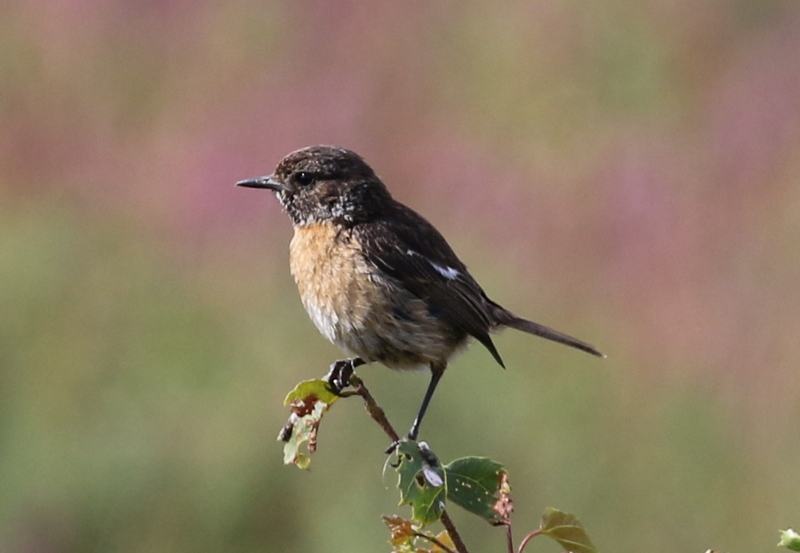 Stonechat – the female was working hard to feed the juveniles
Stonechat – the female was working hard to feed the juveniles
While we were watching the Stonechats, a Dartford Warbler appeared low in the heather nearby. This is not unusual – Dartford Warblers will often follow Stonechats around, possibly for the protection afforded by their extra vigilence. This Dartford Warbler was a juvenile, rather greyish overall, but was hard to get onto, as it was keeping low and moving constantly. We repositioned ourselves and got a slightly better view, but still not everyone had managed to see it.
We watched the Stonechats coming and going for some time. Suddenly an adult Dartford Warbler flew in from behind us and dropped into the gorse among the Stonechats. Again it was quite difficult to see and we only got a couple of glimpses as it fed. Then it flew back out again in the direction it had come.
 Juvenile Stonechat & Linnet – happened to perch in the same bush
Juvenile Stonechat & Linnet – happened to perch in the same bush
Quiet purring behind us alerted us to the presence of another Turtle Dove, such a treat to hear these days, given rapidly how the species is disappearing. We walked round on the path to the other side of the gorse, and we quickly worked out where the noise was coming from but we couldn’t see the Turtle Dove in the thick birch trees. Then suddenly it flew up and started its display flight, flapping higher and then descending in a long glide. It flew out across the heath and landed right in the top of a tall birch, where we could get it in the scope. When it flew again, the Turtle Dove seemed to disappear off over the ridge, but a short while later it was back purring there again. Great views.
 Turtle Dove – purring from the top of a birch
Turtle Dove – purring from the top of a birch
As we walked back round, we came across the Stonechat family again and the juvenile Dartford Warbler had reappeared with them. We watched as it flew back and forth across a clearing and then perched briefly in the very top of a young birch tree. This time, everyone got on it.
We carried on across the Heath and at first there seemed to be a surprising lack of butterflies. Then, as we walked down along a sandy path with short heather either side, we came across our first Silver-studded Blues. Several of them were a bit worn now, but we got a good look at the underside of the wings and the distinctive silver studded spots. There were also a few Graylings along the path. They are next to impossible to see unless they move, and we had to really keep our eyes on them after they landed.
 Silver-studded Blue – this one with rather poorly marked silver studs
Silver-studded Blue – this one with rather poorly marked silver studs
A little further still, as we were following the path round, another juvenile Dartford Warbler flew up beside us. It perched very briefly, but having been surprised by our approach it very quickly disappeared off across the Heath. Not far beyond this, we found a female Dartford Warbler skulking in the gorse. We had several glimpses of her before she flew out and disappeared back across the heather.
While we were trying to keep tabs on the female Dartford Warbler, we heard a male singing back the way we had just come. We raced round there, just in time to see him fly. We followed him round and after a couple of minutes he hopped up briefly into the top of a gorse bush and started singing. After a second or two, he was off again. He flew a bit further away and perched in the top of a large gorse bush to sing. This time he stayed still for a while and we could get him in the scope. When he finally dropped back into the dense gorse, he went quiet.
 Dartford Warbler – the male perched up briefly, singing
Dartford Warbler – the male perched up briefly, singing
As we started to walk back to see if we could find the female Dartford Warbler again, we heard a Woodlark calling and turned to see it flying past. It dropped down some distance from us, but knowing the site well it appeared to go towards another path. We hurried round and found it quietly feeding along the path, giving us very good scope views.
That was a great way to start the day, with all the heathland specialities. We decided to move on so started to walk back to the car. On the way , we flushed another two Woodlarks from the grass beside the path. They flew up before we could see them, but circled round and one perched up in the top of a gorse bush – even nicer views through scope this time.
It was getting on towards lunchtime by now, so we headed down to Cley for lunch. As we got out of the car, we could hear a Whimbrel calling over the car park. After lunch, we walked out to the hides.
Teal Hide was our first port of call. There were quite a few waders on there and the longer we scanned, the more we found. Two Common Sandpipers were feeding close in front of the hide, bobbing constantly. Further over we could see a single Green Sandpiper and a Common Sandpiper together, a nice comparison. A lone Greenshank, slim and elegant, was walking quickly across the scrape feeding, out in middle. There were also good numbers of Black-tailed Godwits and a variety of Ruff in a confusing mix of stages of moult.
It was round into Simmond’s Hide next. There were even more Black-tailed Godwits on here, mostly Icelandic birds, but again a careful look through them and we discovered a bird which looked good for a Continental Black-tailed Godwit (subspecies limosa). In amongst the godwits, were three Red Knot, this time living up to their name and sporting their summer plumage orange-red underparts. A single Turnstone was asleep on one of the islands, but when it woke up we finally got a chance to admire its summer plumage
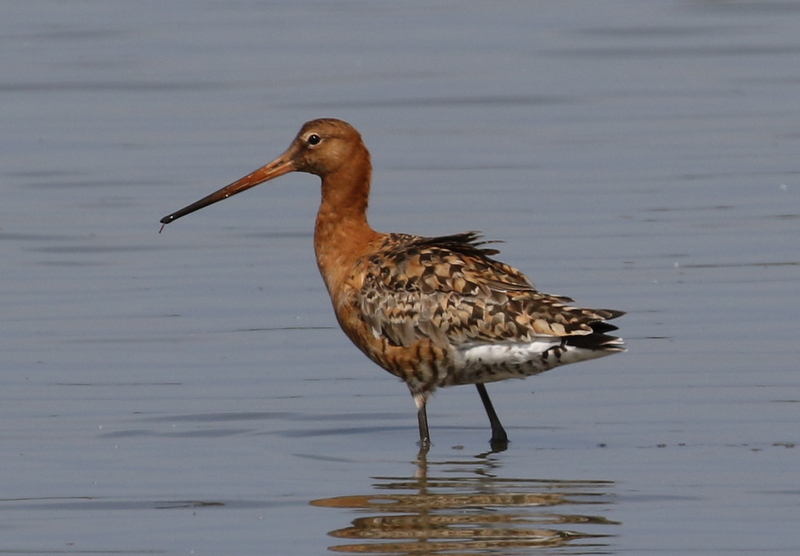 Black-tailed Godwit – a moulting adult islandica
Black-tailed Godwit – a moulting adult islandica
Another Common Sandpiper was hiding in the grass on the edge of one of the islands at the front of the scrape. Several Dunlin were hiding in amongst the godwits legs, including a single juvenile. There are always Avocets on here and today they were particularly argumentative. Two adults and three almost full-grown juveniles seemed to be having some sort of family argument – though it was hard to tell who was who.

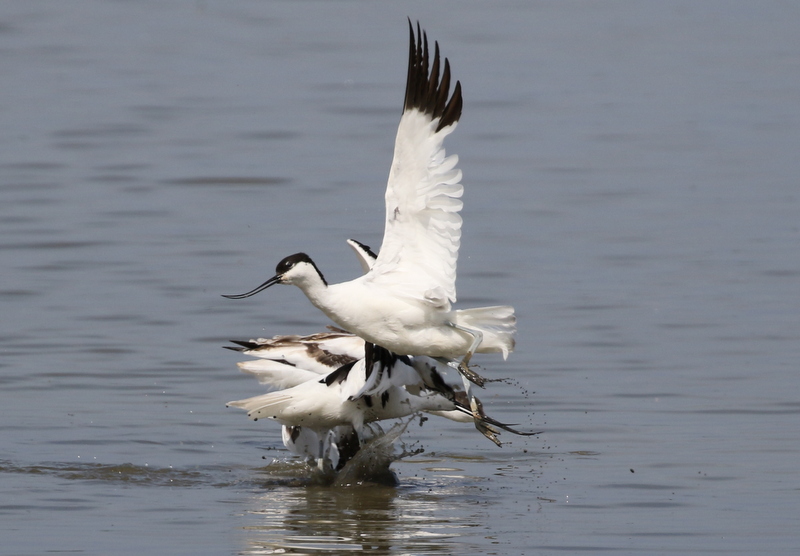
 Avocets – arguing
Avocets – arguing
The ducks are all currently in eclipse plumage, so not looking their best. However, a careful scan through revealed a single eclipse drake Wigeon, our first of the autumn (though it could perhaps be a bird which has over-summered somewhere). A family of juvenile Shoveler were in the grass on the edge of the ditch right in front of the hide. Their largish bills, not yet fully grown but still noticeably big, immediately gave away their identity. There were also lots of Shelduck, and a few Teal.
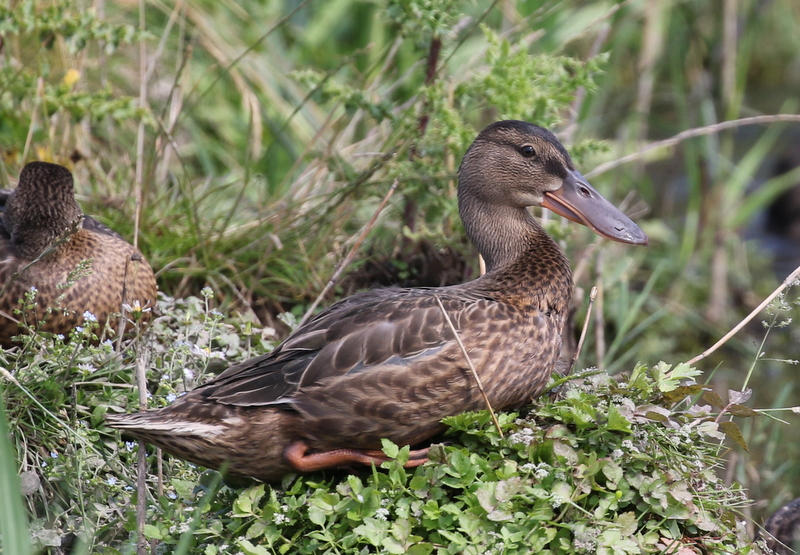 Shoveler – a part-grown juvenile, with a small but already outsized bill
Shoveler – a part-grown juvenile, with a small but already outsized bill
When a Little Egret flew in and walked right to the corner in front of the hide, it surprised a female Gadwall who had just brought her three small ducklings in there. She appeared out of the grass and quickly shooed the egret away.
 Little Egret – scared off by a female Gadwall
Little Egret – scared off by a female Gadwall
There were several dark chocolate-brown juvenile Marsh Harriers in the reedbed and they would occasionally fly round to exercise their wings. Every time they drifted over the scrape, pandemonium ensued. This happened repeatedly while we were there. However, te panic seemed to be even more intense when a Hobby whisked through, putting everything up from North Scrape first, before we spotted it hurtling over Simmond’s and then disappearing off inland.
On the way back, we carried on past the visitor centre and paid a very brief visit to Bishop Hide. There were lots of gulls on Pat’s Pool which were better viewed from this side. They were mostly Black-headed Gulls, plus four Common Gulls, but there was no sign of the hoped-for Mediterranean Gull today. A nice close Common Sandpiper was a bonus.
 Common Sandpiper – our fifth of the day, from Bishop Hide
Common Sandpiper – our fifth of the day, from Bishop Hide
Our next destination was the East Bank. Two fully-grown juvenile Little Grebes were on the new pool. We could hear and see lots of Reed Warblers in reeds. Out on Pope’s Marsh, there were plenty of adult Redshank, with several juveniles still around the Serpentine. A good number of Curlew were hiding out in the long grass.
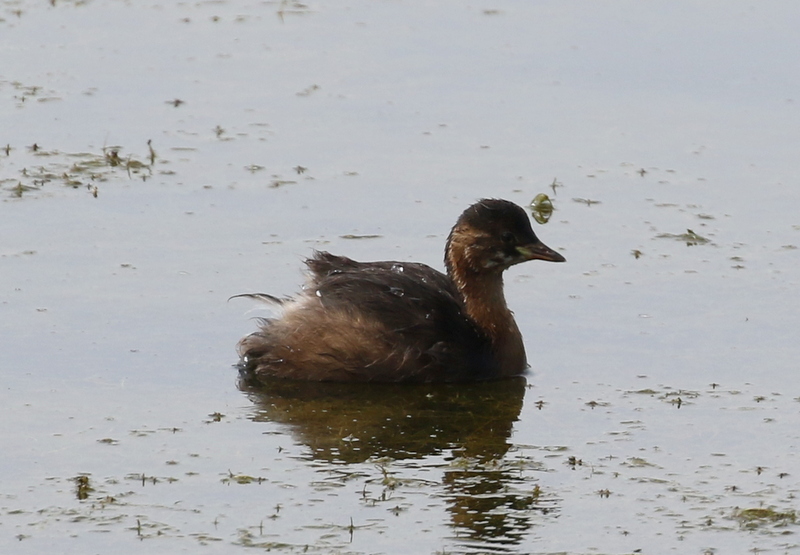 Little Grebe – a juvenile, still with a rather stripey face
Little Grebe – a juvenile, still with a rather stripey face
Arnold’s Marsh looked relatively quiet. There are not so many Sandwich Terns on here this year, possibly because the number breeding on Blakeney Point is well down on previous years. Three or four Ringed Plovers were lurking on the shingle islands. A lone Greenshank was walking back and forth. The single Red Knot promptly flew off just after we arrived.
Returning back to the car, we headed round to the beach car park next. As we walked out towards North Hide (or at least where it used to be!), we stopped by the little pool next to the fence. This was very productive, with at least 3 juvenile Yellow Wagtails, along with a lot of Pied Wagtails, Meadow Pipits and two Little Ringed Plover.
Even though the Wood Sandpiper which has been here for the last couple of days, had not been reported today, it still seemed worth a look. The first bird we saw when we sat down was the Wood Sandpiper, conveniently standing with two Redshank for comparison. We watched it picking around on the mud as it walked directly towards the hide, and eventually we lost it to view behind the vegetation in front of the hide. Still, it was well worth coming out here for that alone. There was not much else out here – a small party of Dunlin at the back and several Redshank.
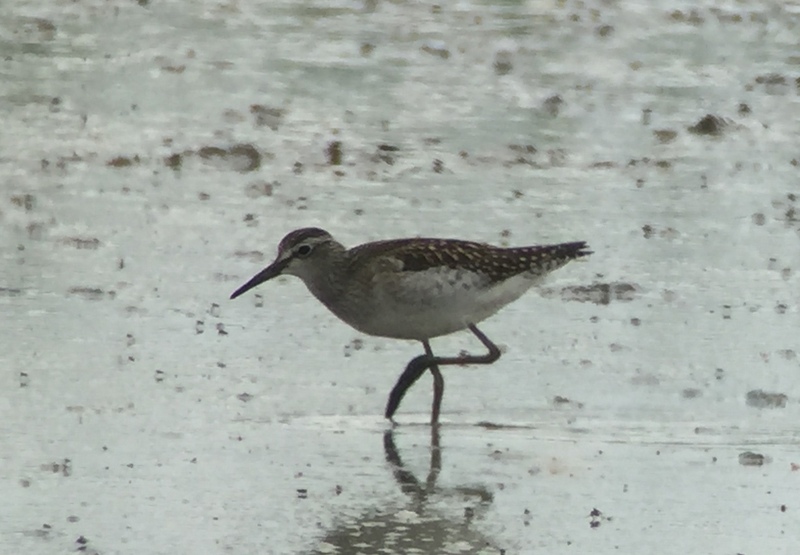 Wood Sandpiper – on North Scrake
Wood Sandpiper – on North Scrake
Time was getting on, so we decided to head back – it had been a nice way to round of the day with a smart Wood Sandpiper.
















